I have the extraordinary pleasure of enjoying what I do for a paycheck. I did make a post about it once, but in case you've just stumbled upon this I'll let you know that I am an Aircraft Rescue Firefighter.
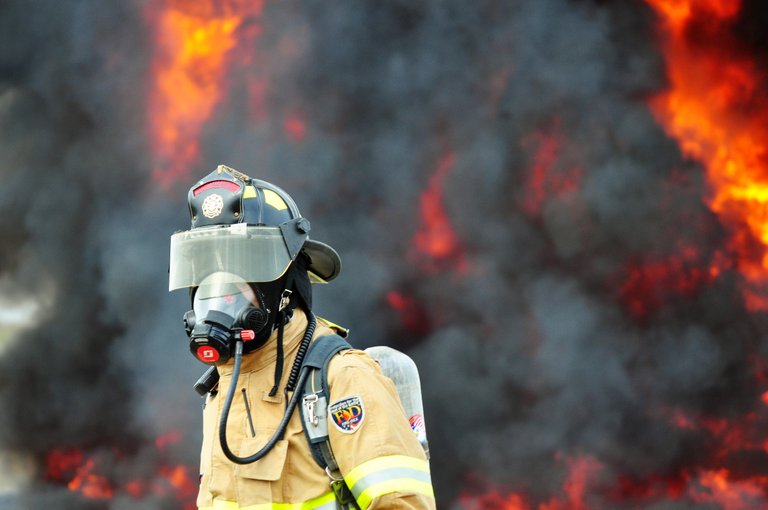
That's me with a towering inferno at my back like I just don't care.
The discipline of Aircraft Rescue and Firefighting involves a lot of training in order to keep our skills sharp. The aviation industry is very safe, so real world responses are infrequent. The only aircraft crashes I have responded to are General Aviation: relatively small aircraft like the popular Super Cub, some version of Cessna, or the larger Beaver. Our department serves the world's busiest seaplane base in addition to the International airport, so most crashes involve the private, civilian pilots who take-off and land there.
And when it comes to putting out fires, it’s commonly airfield maintenance equipment that catches ablaze, not aircraft.
While most days pass by safely—or with only minor incidents—we remain vigilant, constantly aware of the potential to respond to "the big one" at any moment without warning. The plethora of Boeing 747 cargo aircraft flying through the airport can carry over 200,000 liters of fuel. The passenger 737 adds a large number of people possibly needing rescue to its 26,000 liters of fuel.
Those enormous amounts of fuel behave in unique ways and present unique challenges when it catches fire, so to prepare for this we set a massive fuel fire once a year to practice our techniques (also, the annual training fires are required by the FAA).
This year I was assigned to the ignition team: two firefighters who walk into the pit of 1,800 liters of diesel fuel to start the fire. I had not had this assignment in prior years since it's usually given to senior firefighters who are also instructors... which I suppose describes me nowadays.
After a tanker pumps the diesel fuel into the pit through a pipe system the ignition team enters. One member has a tank of regular gasoline while the other follows with a torch rod. I make sure to give him some space, since our two items have quite a reaction with each other.
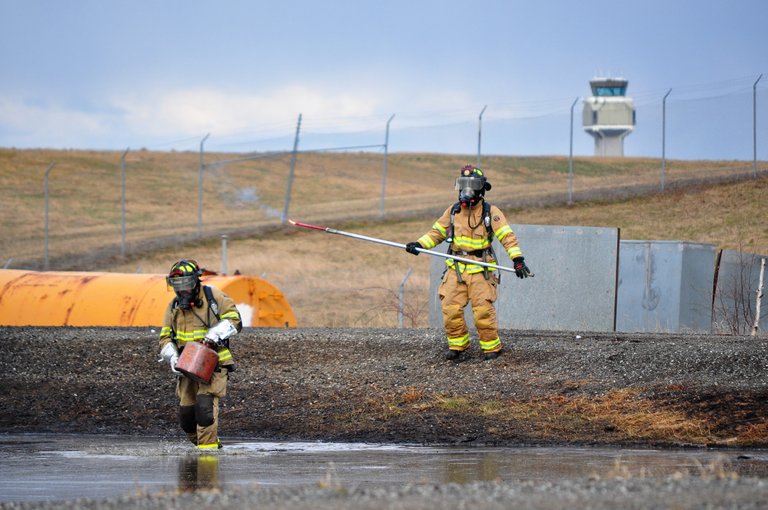
I'm the one with the flare at the end of a long stick. My tiny little flame is the seed for something much bigger.
So why does a guy carrying a can of gas walk into all that diesel followed by a guy holding a torch?
Gasoline and diesel fuel have very different flash points. The fumes of gasoline will ignite at a much lower temperature than diesel—any temperature found on our planet except for maybe Antarctica in the heart of winter. Diesel fumes on the other hand will not ignite unless they reach 126 °F (that's 52 °C for my brothers and sisters elsewhere in the world).
I could touch the surface of that diesel with my torch all I want, but it will not ignite since it's nowhere close to 126 degrees outside. My partner pours a small pool of gasoline, which I ignite easily with the flare.
The burning gasoline raises the temperature of the diesel. When it reaches its flashpoint, the flame will spread over the diesel fuel, slowly creeping across the surface as it brings the temperature up.
This doesn't happen too quickly, so we light one or two other small spots, adding more heat to encourage the diesel to reach that magic temp. Of course, once it gets going the blaze is on, so we don't waste our time in there either.
It's a challenge getting the timing right. The wind pushes the fuel across the surface, so when you're walking through the pit you need to read the wind and make decisions on where your starting spots will be in order to achieve the largest possible inferno. It's hard to not feel like there's a little bit of an art to it, and on this particular fire I had refined my methods.
I called for the ignition team to exit and the trucks began their response to quench the amazing beast I had built. It's amazing to stand next to this tower and feel the incredible heat. I could hear the fuel violently boiling like sizzling fat on a roasting pig. The smoke rolled high above me and the flames bloomed in and out of the black veil. Flames dance in smaller fires, but when an inferno is this large they move like churning waves.
I built five fires that day. This was the biggest one.
Two Oshkosh 4500 Strikers manned by my shift-mates arrived on the simulated scene. The 4500 represents the amount of water carried by the apparatus.
With a combined nine-thousand gallons of water it still took considerable effort to extinguish the fire. I smiled. Not just because I built an amazing fire that's beautiful and frightening at the same time, but because it was providing my coworkers with a great training experience.
The wind will commonly push the fuel to one end of the pit, making the fire smaller and easier to put out. This was the most dynamic fire of the day, and rather than the engine crews rolling up and it putting it out in a couple of minutes, this one put up a fight.
In a real emergency we would use a foam agent called AFFF which is exceedingly effective. But that would be too easy for training (and make lighting additional fires much more difficult), so for these fires we only use water which allows us to actually work the fire and learn from its behavior.
Another thing you might find interesting: each year we alternate fighting the fires with our apparatus turrets and walking in with hand carried hoselines.
These apparatus are specifically designed for aircraft rescue firefighting, and you can see how they're an effective tool for the job. Typical fire engines hold much less water, as they function using an extensive network of fire hydrants—an endless water supply. Well, you can't put hydrants on an airfield, so we have to bring our water with us. These training fires are still a fraction of the potential size of blaze that can result from an aircraft emergency.
I hope you enjoyed these photos and the glimpse inside the type of training we do to prepare for one of the worst case scenarios we might have to deal with while on the job.

I couldn't pass up the chance to get a photo without my SCBA (Self Contained Breathing Apparatus) mask on. That's a special hair-style that can only be created by working with all that gear on and then ripping it off in dramatic fashion. No hair-product necessary.
I'd like to take a moment to mention The Writer's Block. If you're a writer looking to improve and get involved in a free network of peer editors, please click the image to the left. A bastion of fiction, non-fiction, and poetry, TWB is a wonderful community offering an abundance of opportunity and fun. Special thanks to @AnikeKirsten for offering her edits on this piece.
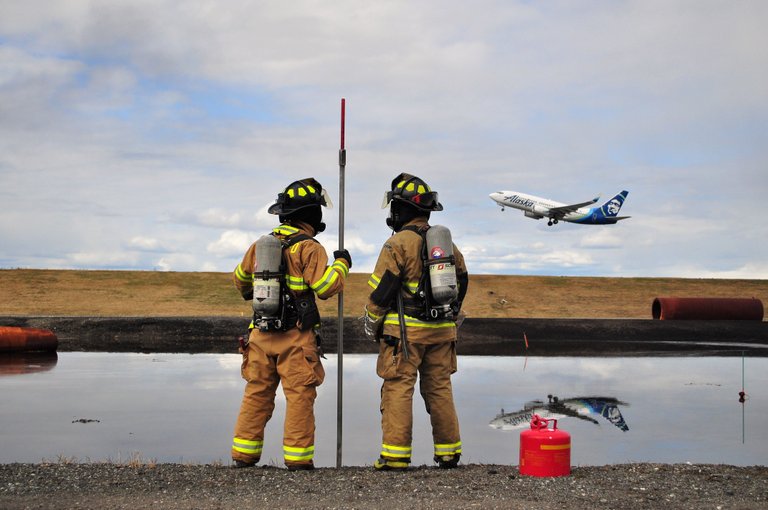
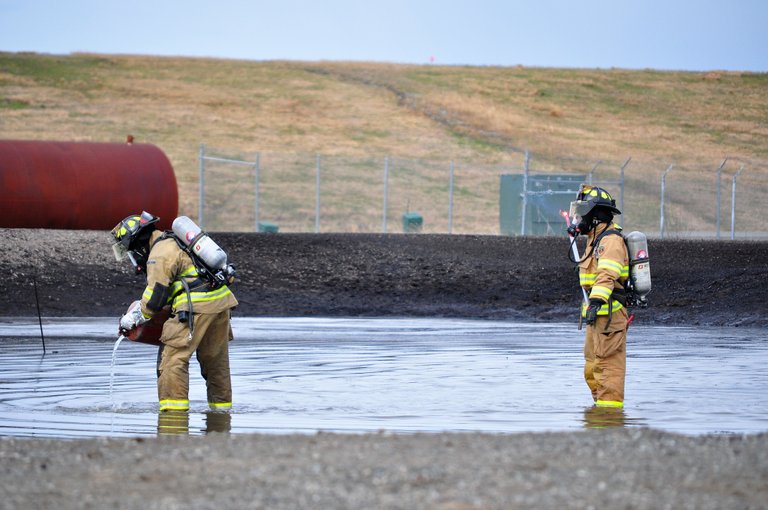

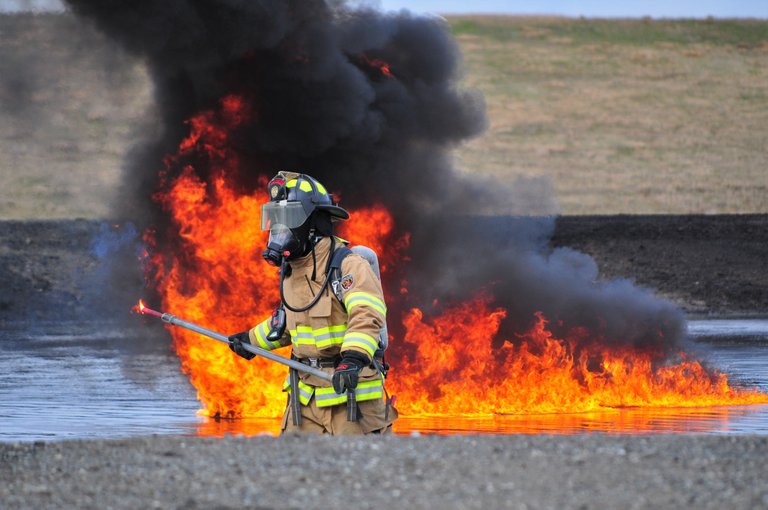
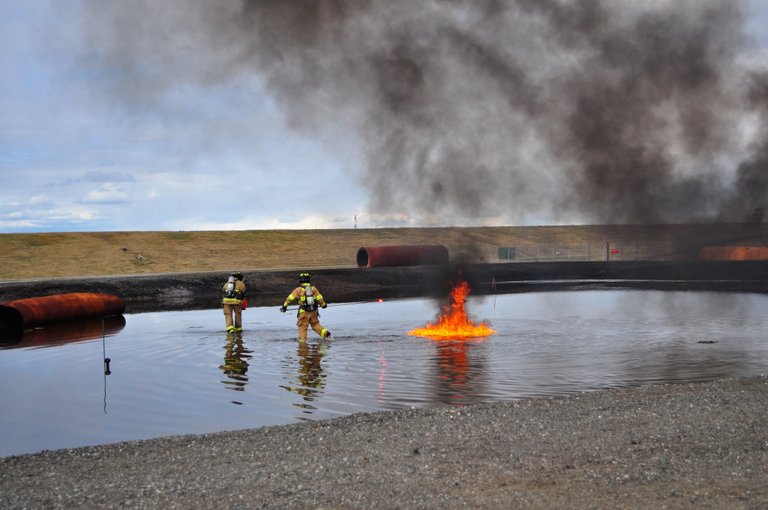

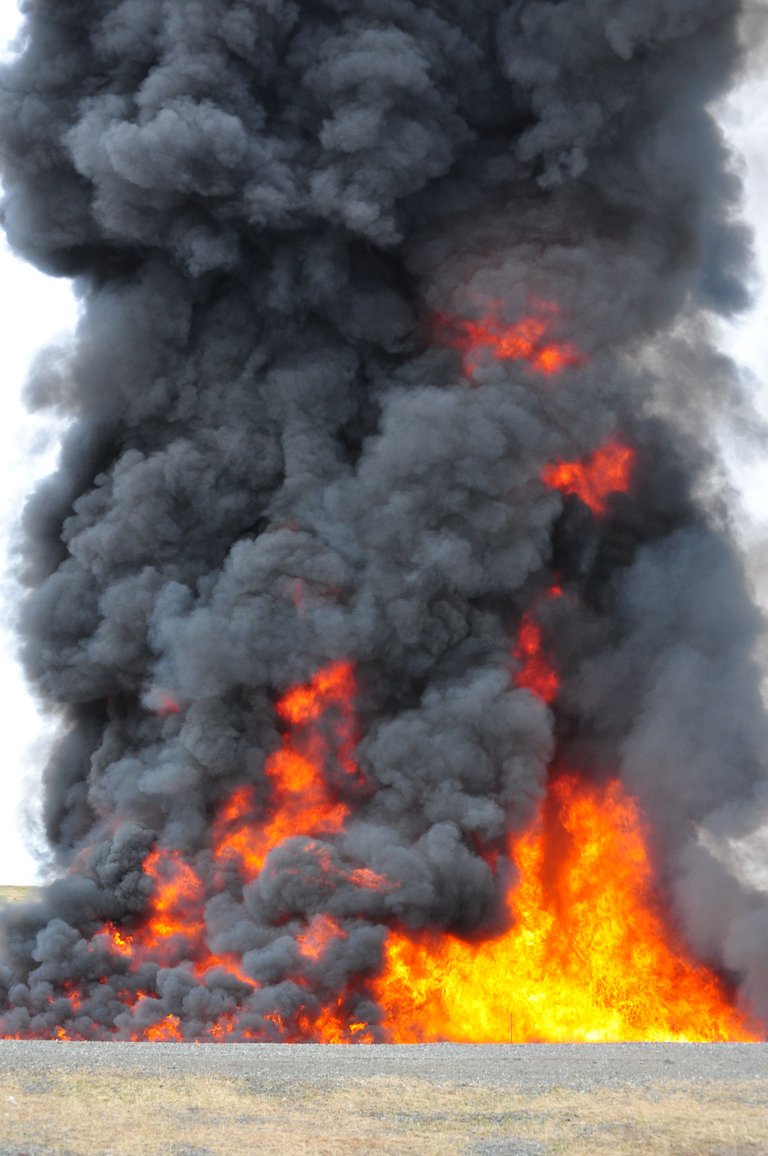
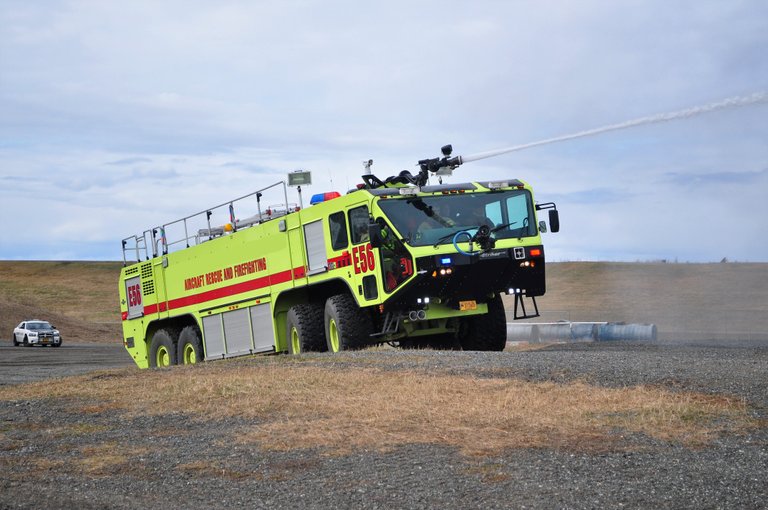
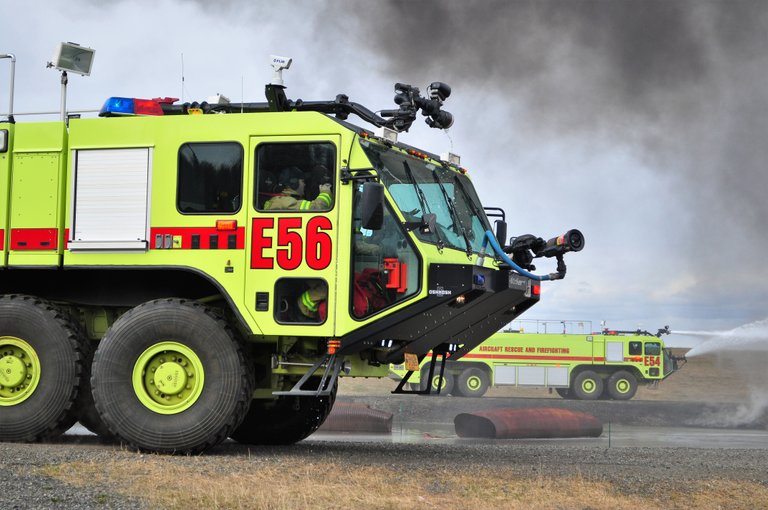
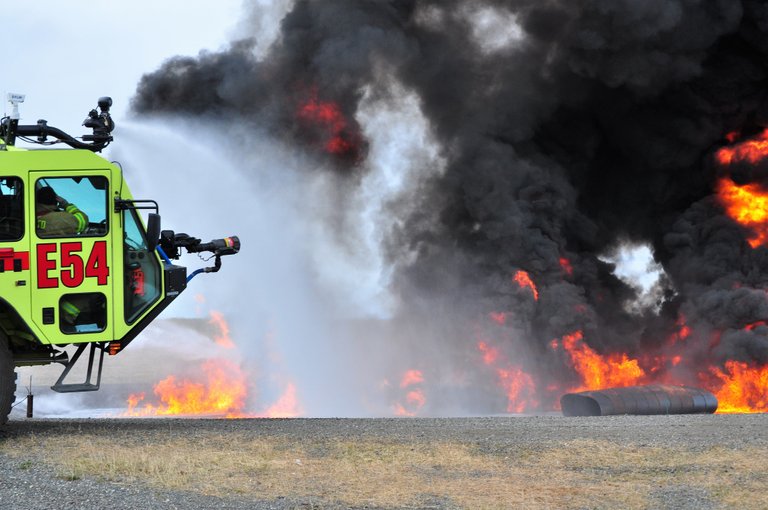
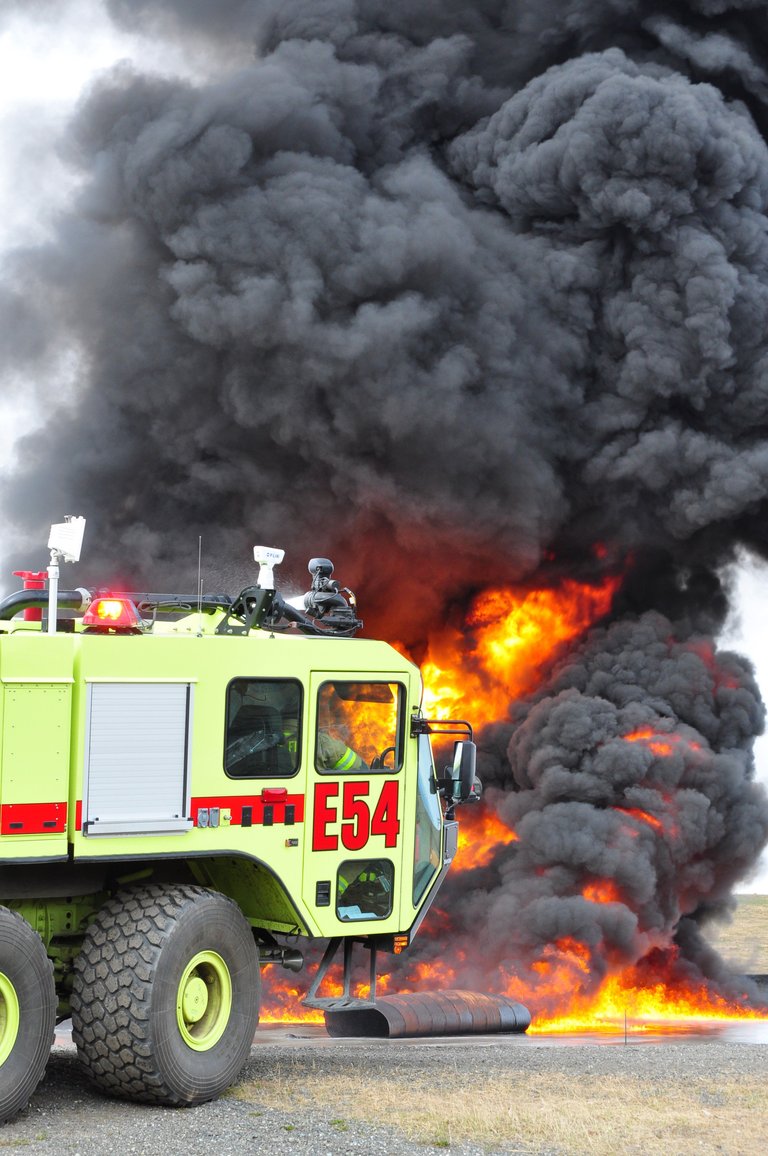

Awesome stuff! Love being able to live vicariously through you as you get to literally play with fire, haha! Lovely photos, and I especially love the shot at the end.
Thanks Rose! It is fun to share cool stuff like this with everyone at TWB from time to time. I'm conflicted in that photo at the end--it is neat having a picture of yourself in front of a huge fire, but I feel like I look 10 years older in that photo. Haha. I blame the hood/mask/helmet hair and bunker gear making it look like I have no neck.
That was very cool to read. Thanks for the awesome photos too. I can imagine it is quite a lot of fun training with fires that large. I'm a volunteer firefighter in NZ in a wee town. We dont deal with many fires that large. Keep up the good work!!
the photo you've posted a long while back in your feed. That's beautiful. I'd love to see some more pictures like that.Thank you @stbathans! I'm glad you enjoyed and it's great to get a comment from a fellow firefighter. Glad you enjoyed the photos--I'm pretty happy with how they turned out too. It is indeed a pretty amazing thing to train with fires this large. Very cool that you live in New Zealand. I noticed
Hi aksounder,
LEARN MORE: Join Curie on Discord chat and check the pinned notes (pushpin icon, upper right) for Curie Whitepaper, FAQ and most recent guidelines.
Not sure if anyone reviews the replies to these comments, but if so, thank you!
Curie is a huge motivator to me for making these types of posts. I love sharing with the community, but curie feels like a badge of recognition.
In the sea of bots, spam comments, and countless dead followers, manual curation projects like curie are a piece of what makes Steemit great.
To Curians and all others who contribute to manual curation projects, thank you.
While we do not always see replies to this automatic (we have to save time somewhere lol) comment - I do look at ALMOST every post we upvote to pick which ones to use in the Author Showcase and catch some of them.
On behalf of all my fellow curators at Curie - You're very welcome. And your vote was very well-deserved.
This us such an awesome post, @aksounder. It’s neat to see what you do professionally, but in addition to that, the images are breathtaking and the information is fascinating. I never really thought about fire behavior, but that makes so much sense. The conditions including wind and temperature would affect everything. I really enjoyed reading this!
Thank you Jayna, I really appriciate your comments. I'm glad to hear it seems I hit my target of educational and fun text to accompany these cool photos.
What an amazingly interesting and dangerous job you have. Your photos are stunning. Thanks for sharing it all.
This post was nominated by a @curie curator to be featured in an upcoming Author Showcase that will be posted Late Monday/Early Tuesday (U.S. time) on the @curie blog.
NOTE: If you would like us to NOT feature your post in the Author Showcase please reply, email, or DM me on Discord as soon as possible. Any photos or quoted text from your post that we feature will be properly attributed to you as the author.
You can check out our previous Author Showcase to get an idea of what we are doing with these posts.
Thanks for your time and for creating great content.
Gene (@curie curator)
Aweskme! Thank you.
Wow, thanks for letting us walk in your
shoesboots for a bit. The Strikers are beautiful machines. Just how the hell do you get the diesel smell out of your bunkers? Eww.Love the post... nice shot at the end too... one for the office wall. Stay safe.
Glad you enjoyed it and thanks for the comment Jason. The Strikers are pretty amazing. I've been thinking of doing a post that's a tour of the Striker some time. There would be a lot of pictures and maybe a video or two.
We have a special extraction washer machine for bunker gear at the station. It doesn't get it completely out, that's why we try to plan ahead and hang on to a previously issued set of bunkers for pit day. I'm sure the diesel breaks down some of the protective properties of the gear over time, so the ignition team avoids using their current in-service bunkers used on-duty.
Ya, that would be awesome. Do a 360 view... ah yes, spare gear makes a lot of sense.
I know I've told you this before, but you have a ridiculously cool job.
Thanks Mountain. I can't say I don't agree. 😆
This is epic, legendary, awesome, (insert other cool word used today to express astonishment)! The fires look beautiful, in a rather frightening way, but you're all cool and calm. Learned quite a lot about fighting fires. Much respect for you and all firefighters.
Thanks AK. The fire was beautiful. It's surreal to watch one so huge, see the orange flame roll in and out of the huge collumn of smoke, feel the heat and hear that fuel sizzling. It's very rare to stand as close as I did and I would have stayed longer if the trucks weren't on the way. The moment was brief and I needed to get the F outta there because I prefer not being squished by a Striker. Oh, and I'm not talking about that last photo with my gear off. That's the safe area where those of us not a part of the response stood to watch. I mean after I lit this one off I stood at the top of the bank for a moment right next to it.
Whoa! So the flames could almost lick you, haha. Fire is powerful and you probably felt like a demigod standing there.
Really cool read, and excellent photos to go along with your excellent commentary.
I can't help but see the Disaster Girl meme in your last photo. Your hair is better than hers, but otherwise almost exactly the same pic.
Hahaha, oh man, I totally forgot about that meme! I should have had a more mischievous and evil look on my face like her.
Thanks for the comment and kind words Neg... especially the bit about my hair. 😉
Awesome post and awesome photos. Us regular folks are really lucky people like you work hard and risk your lives to help keep us safe! Thank you for all you do.
Thank you Bex. We work hard sometimes but have the fortune of some interspersed leasure while on duty at times too. I'm pretty sure I can speak for the majority of first responders when I say those of us that stay in this line of work after the first couple of years really love what we do. I've had a few different kinds of jobs before this--even went to University for something entirely different--but now I can't imagine doing anything else for a living.
But the risk is there every time anything happens. So while you may love what you do, you're still putting your life on the line... which can't be easy with a family to worry about.
True, but there's a lot of training and proceedure to minimize that risk in firefighting. We aren't really allowed to put ourselves in undue risk, because if the rescuer becomes a victim you just caused a lot more work for your buddies, taking away resources for those that initially needed rescue.
It's other aspects of my job at my current department that cause more concern in that area for me, which I have brought up once or twice in mod channels at TWB. I think you know what I'm referring to. So in that case, yes, it's not always easy.
This post was shared in the Curation Collective Discord community for curators, and upvoted and resteemed by the @c-squared community account after manual review.
Outstanding. Thanks for the support!
Congratulations @aksounder! You have completed some achievement on Steemit and have been rewarded with new badge(s) :
<p dir="auto"><a href="http://steemitboard.com/@aksounder" target="_blank" rel="noreferrer noopener" title="This link will take you away from hive.blog" class="external_link"><img src="https://images.hive.blog/768x0/https://steemitimages.com/70x80/http://steemitboard.com/notifications/votes.png" srcset="https://images.hive.blog/768x0/https://steemitimages.com/70x80/http://steemitboard.com/notifications/votes.png 1x, https://images.hive.blog/1536x0/https://steemitimages.com/70x80/http://steemitboard.com/notifications/votes.png 2x" /> Award for the number of upvotes <p dir="auto"><sub><em>Click on the badge to view your Board of Honor.<br /> <sub><em>If you no longer want to receive notifications, reply to this comment with the word <code>STOP <blockquote> <p dir="auto">Do you like <a href="https://steemit.com/@steemitboard" target="_blank" rel="noreferrer noopener" title="This link will take you away from hive.blog" class="external_link">SteemitBoard's project? Then <strong><a href="https://v2.steemconnect.com/sign/account-witness-vote?witness=steemitboard&approve=1" target="_blank" rel="noreferrer noopener" title="This link will take you away from hive.blog" class="external_link">Vote for its witness and <strong>get one more award!Not much to say that hasn't already been said here, but I really enjoyed the subtle understatement in the following:
Chic article. I learned a lot of interesting and cognitive. I'm screwed up with you, I'll be glad to reciprocal subscription))
Considering you posted this comment exactly one minute after I published this article, I'm going with a reasonable hunch that you didn't actually read it. Spamming and telling someone you're "screwed up with" them and asking for reciprocation isn't the path to building a strong community.
Also, seeing your comment history shows this same text copy-pasted in several comments. Thanks but no thanks. You earned a flag.